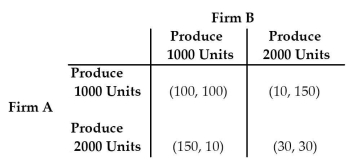Multiple Choice
The payoff matrix below shows the payoffs to Firms A and B from producing different levels of output.The numbers in parentheses are (payoff to A,payoff to B) .  TABLE 11-3
TABLE 11-3
-Refer to Table 11-3.From the payoff matrix we can infer that
A) it is optimal for Firm A to produce 1000 units of output regardless of what Firm B is doing.
B) both firms are indifferent between an equilibrium (Produce 1000 units,Produce 1000 units) and (Produce 2000 units,Produce 2000 units) .
C) it is optimal for Firm A to produce 2000 units of output regardless of what Firm B is doing.
D) it is optimal for Firm B to produce 1000 units of output regardless of what Firm A is doing.
E) there is no Nash equilibrium in the game.
Correct Answer:

Verified
Correct Answer:
Verified
Q105: One difference between a perfectly competitive market
Q106: Suppose two firms,Allstom from France,and Bombardier from
Q107: The diagram below shows demand and cost
Q108: Consider the following characteristics of a particular
Q109: Which of the following characteristics is NOT
Q111: Consider an example of the prisoner's dilemma
Q112: Suppose that a monopolistically competitive firm decides
Q113: The payoff matrix below shows the payoffs
Q114: A characteristic common to most imperfectly competitive
Q115: The sugar industry in Canada is effectively